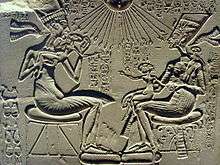Panehesy
Panehesy (also transcribed as Pinhasy[1] or Panehsy[2]) was an Egyptian noble who bore the titles of 'Chief servitor of the Aten in the temple of Aten in Akhetaten' ('Second Prophet of the Lord of the Two Lands').
.jpg)
Titles

Panehesy held a variety of titles that show how powerful he must have been during the Amarna Period. He was the 'Chief servitor of the Aten in the temple of Aten in Akhetaten' and 'Second Prophet of the Lord of the Two Lands'. He was also the 'Seal-bearer of Lower Egypt'.[3]
Panehsy was also the 'Superintendent of the Cattle of the Aten in Akhetaten' and the 'Superintendent of the Granary of the Aten'.[2]
Houses

Panehesy had two houses in Amarna. One was located near the temple, while another was located in the Central City. The house near the temple was likely more of an office.[2]
The main residence of Panehesy (R44.2) lies in the Central City of Amarna.[4] In his main residence a large shrine was discovered which depicted Akhenaten, Nefertiti, and princess Meritaten making offerings to the Aten. This is an example of the domestic cult of the royal couple. The hypaethral chapel was located within the central hall. To the south of Panehesy's home was a small village. The total area occupied by the village is less than the area occupied by the main residence of the Priest. The village consists of some 40 houses that were likely the residences of Panehesy's staff.[5] In the vicinity of the home a stele was discovered depicting Amenhotep III and Queen Tiye.[1]
The second residence of Panehesy near the temple of the Aten may be related to his function as the overseer of the cattle. The structure includes stone floors and brick mangers and may have served as a holding pen for the cattle. Excavations revealed remains of cattle, horn and bones. The bones were the remains of the cattle butchered for the offerings in the temple.[6] The central hall of this house held a stone built shrine painted to look like an Amarna Temple. The structure held narrow wooden doors and likely held a statue of the King. The shrine is now at the Cairo Museum.[7]
Tomb
He had a tomb constructed at Amarna, among the northern tombs among the Tombs of the Nobles. The Tomb of Panehsy[8] (Amarna Tomb 6) contains scenes of himself and his family[9] and others showing the royal family,[10] but his remains have never been identified. The tomb had suffered damage from iconoclasts. The images of Akhenaten and Nefertiti had been disfigured, and most of the names had been removed.[1]
In later times, his tomb was turned into a Coptic place of worship for a while[11] and suffered damage. A deep font for total immersion was placed before the apse.[1]
References
- Aldred, Cyril, Akhenaten: King of Egypt ,Thames and Hudson, 1991 (paperback), ISBN 0-500-27621-8, pg 16,18,24,66,131,222
- Kemp, Barry, The City of Akhenaten and Nefertiti: Amarna and its People, Thames and Hudson, 2012
- Aayko Eyma, ed., A Delta-Man in Yebu: Occasional Volume of the Egyptologists' Electronic Forum No. 1, p.35
- Journal of the Manchester Egyptian and Oriental Society by Manchester Egyptian and Oriental Society, Manchester University Press 1935, p.19
- Kemp, pp 44-45 including figure of the house and the village.
- Kemp, pp 110-111
- Kemp, pg 230, 232
- "Archived copy". Archived from the original on 2006-09-25. Retrieved 2006-08-06.CS1 maint: archived copy as title (link) Amarna North Tomb 6
- Gay Robins, Ann S. Fowler, Proportion and Style in Ancient Egyptian Art, University of Texas Press 1994, pp.130f.
- Robert Hari, New Kingdom - Amarna Period: The Great Hymn to Aten, Brill 1985, p.24
- Robins & Fowler, p.60
